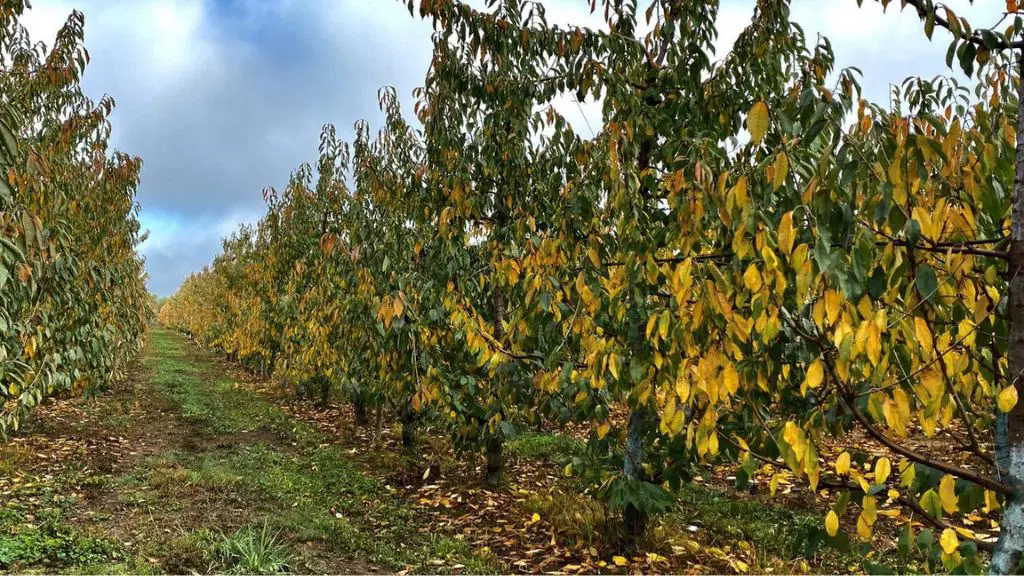- The main objective in this transition stage is to have the beginning of physiological dormancy around November 1st.
Physiological dormancy can be recognized when the tree reaches at least 50% of the fallen leaves, always considering that yellow leaves are understood as fallen leaves as well. This ensures an acclimatized plant that is strong enough to withstand low temperatures and frost events during the dormant period.
What should be considered so that plants can acclimatize quickly and enter a dormant period optimally?
Postharvest nutrition:
Regarding the management of postharvest nutrition and fertilization, the months of July and August are those that are considered the most important in terms of orchard recovery. This means that both the prevention of thermal stress, as well as soil and foliar fertilization based on the results, are vital to ensure reserves and start a new season after the dormancy stage.
The month of September is recognized as a transition month at the beginning of the winter dormancy stage, which is why it is important to generate a signal to the plant from a nutritional point of view and not continue fertilizing beyond the second fortnight, so as not to overstimulate the plant or maintain a vegetative state until very late in the season. This considers both soil fertilization and postharvest foliar programs.
Irrigation programming and management:
The plant ‘s atmospheric demand and water consumption are decreasing towards the end of August and beginning September. The demand is expressed in evaporation and not in environmental temperature. This is important to understand, because although there may be warm temperatures at this time, they last only a few hours in the day and are not comparable to the same maximum temperatures in midsummer.
At the same time, the nights and mornings have much more marked low temperatures and a high presence of humidity, this is the basis for the decrease in irrigation frequency towards the month of September. It is very important to use tools that help make objective decisions for this: Calipers, humidity sensors, blood pressure monitors, etc.
The change in irrigation frequency (not time) under normal conditions should decrease between 30% and 50% of what is established in summer.
In general, irrigation should be suspended towards the end of September. This generates a signal to the plant and begins the lignification process of wood and fruit centers so that the plant can better withstand the low winter temperatures. However, in soil conditions with lower water retention, such as sandy soils and also with the presence of stones, the cessation of the irrigation season should be postponed until approximately October 10.
In special situations, you could water again at the beginning of autumn and the beginning of very dry winter, but never before recognizing physiological dormancy, represented as at least 50% fallen leaves (yellow leaves are considered fallen leaves).
Use of Molybdenum (Mo) as a complement to plant acclimatization:
There is a lot of talk about the action of Mo as an enhancer of leaf fall or as a causal agent of the physiological entry of plants. However, this component acts nutritionally, moderating and enhancing the action of some nutrients, such as distributing the different nitrogenous forms that are in the plants, in favor of reserves, and the action of some phytohormones such as ethylene and abscisic acid, the latter causing the fall of leaves naturally in autumn.
Foliar applications of Mo during the month of September have shown to be effective in an acclimatization process, mainly of young plants; this, especially in colder areas to enhance the hardening and lignification of plants in order to improve adaptation to the process of leaf fall and to be able to better withstand low winter temperatures, favoring the condition of the plants from the from a phytosanitary point of view.
A plant adapted to the environment, often through the use of foliar Mo, may have greater options to carry out the process of leaf fall in a natural and normal way to the extent that there are environmental signals that allow it. In this case a constant drop in ambient temperatures. There are many commercial options for Mo formulated to apply foliarly on the market, and the concentrations for use according to the manufacturer must always be respected.
Strategy to complement leaf fall:
The specific consideration is that physiological dormancy should ideally be present at the beginning of the month of November. The first cultural signal to the plant to begin entering dormancy is to stop watering towards the end of September; This is complemented by the cessation of soil and foliar fertilization towards the end of August. After this, the state of yellowness and/or falling leaves must be evaluated (yellow leaf = fallen leaf).
This evaluation analysis should be done around October 15 to 20, since it is a reasonable time for the plants to present changes based on what has been done. If on that date there is no sign of leaf fall, a chemical strategy must be applied to ensure leaf fall.
Tests have been carried out that allow a rapid response to throw away leaves if necessary, the most effective being the least “natural”, which is through tissue “intoxication”.
In this case, it is recognized that the sulfate ion (SO 4), presented in some nutrients, generates intoxication of green tissues when used in high concentrations, which is why it is the way to stop the work of the leaves and generate abscission. However, the mixture with urea has enhanced the decomposition effect, generating a rapid fall.
The mixture between a “de” Sulfate (Zn Sulfate the most used) plus Urea, as a complement to throwing away leaves in a last resort terminal strategy. The use concentrations of both formulated products are between 1% and 2%, always mixed. Up to two applications could be made at intervals of 7 to 10 days if necessary.
Coverage should be used according to the volume of the canopy and always favor reaching the last shoot in height.










